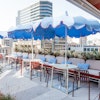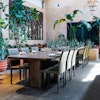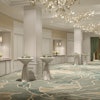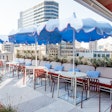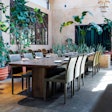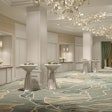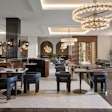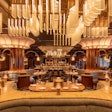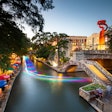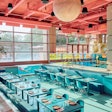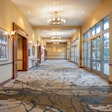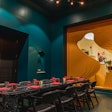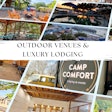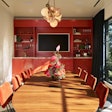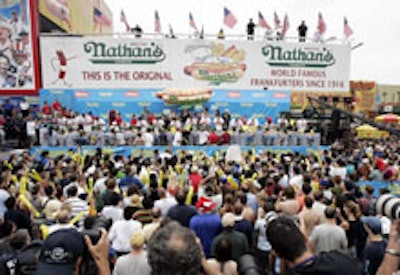
The 2007 Nathan's hot dog eating contest.
Photo: Stan Honda/Getty Images
Prepare for a crowd. “You [can] anticipate a crowd size, but you have to keep in mind it could be much smaller or larger,” says George Shea, the partner at marketing firm Shea Communications responsible for orchestrating the annual Nathan’s hot dog eating contest on Coney Island in Brooklyn. “This year we had 50,000 spectators, and that was something we hadn’t anticipated. Some of the ones in the back couldn’t see. We talked about having a JumboTron but didn’t do it. We plan to for next year.
“Two years ago, audience attendance shot up. There were so many people that the N.Y.P.D. had to shut down [the street in front of the contest] and our Bus of Champions couldn’t get in. They had to loop the bus around side streets, which made them late. Now we have a different route that takes spectator overflow into account.”Practice your debating skills. “I get to deal with so many different personalities,” says J. Scott Wunn, executive secretary of the Ripon, Wisconsin-based National Forensic League, which organizes the National Speech and Debate Tournament for high school students. “There’s nothing more colorful than a disappointed coach or parent [who’s] upset about something surrounding their child. Most debate and speech coaches are type A personalities, and some of them are great debaters. Imagine dealing with one when they’re upset—you don’t get by with a ‘because I said so’ response.”
Timing is everything. “The Nathan’s staff has to provide 1,500 hot dogs and have them be not too hot and not too cold. They dedicate a whole line of grills just for the contestants,” says Shea. “There have been times when Nathan’s didn’t anticipate the number of hot dogs the contestants were going to eat, and they had to give them ones that were too hot off the grill.”
Get your shots. “This year at the event we had a measles outbreak, and it was right on the heels of that international TB scare,” says Cait Goldberg, director of events for Science Service, the Washington, D.C.-based organization that runs the Intel International Science and Engineering Fair. “I guess I wasn’t aware that people coming into this country didn’t have to get shots and could contract measles, but when one girl came down with it, we realized all of our international delegates were at risk. Fortunately, the Centers for Disease Control were on the ball, and we set up a clinic. We got information out a number of different ways. We were able to send out email to participants, we announced it at an event where everyone was together at one time, we shot the information around to various hotels, and we put information up on screens around the convention center.
“You’d be surprised by how many people had to come in for a shot. We gave out a couple hundred over the course of the event. No one contracted it [other than] one girl, because we were able to jump on it and get the word out. It worked out amazingly well, given that we were blown away by this It wasn’t in our crisis plan. It was nothing we’d dealt with before.
Start security preparations early. “We do our final-night dinner at the State Department dining room in Washington, D.C. It’s a pretty fancy deal,” says Steven Dunbar, programs director at the Mathematical Association of America, which organizes the annual American Mathematics Competitions for students. “Lately, security has been a big headache. We have to submit background information on all the participants, including names, ad dresses, driver’s license numbers, and Social Security numbers. We probably have one or two kids a year who aren’t citizens, so they have to do a little bit extra, like tracking down passport and green-card info to submit. It’s like airport security, but even more so. You have to go through two separate metal detectors, have your bags X-rayed, and then be escorted to the room by guards.”
Don’t count on the weather. “There are 90 different sand castles every year, and the tallest ones will be about 12 feet tall and take up a 20- by 25-foot site,” says Joe D. Powers, committee chair for the AIA Sandcastle Competition in Galveston, Texas. “We have a plan of the beach that’s published way back in April, and we have to clear the beach and have a survey crew lay out all the sites so that each team’s site has 10 cubic yards of sand.
“Last year the tide was extremely high, so we had to regrid all of the sites just two days before the event. Next year we’re going to plan for it by moving the competition further east, where the beach gets wider. This year we had to do a lot of stuff on the fl y. If the tide comes in and washes your sand castle away after five hours of work, you’re going to be mad.”
Don’t take no for an answer. “People will give you a response sometimes based on convenience,” says Wunn of the speech and debate tournament. “We put our finalists on a big stage, and there’s a JumboTron above their heads. It takes about a day and a half to set up that AV. I got to the site, and the JumboTron looked like a picture-in-picture. It turned out that the camera was at the wrong angle, so they were catching some of the screen in the shot. I said the camera had to be raised, and the production guys said they couldn’t do it. I pulled the AV crew to the side and had to say, ‘This is a “you don’t want to do.” This isn’t a “you can’t.”’ I told them I’d pay them overtime to have it done in 30 minutes, and they did. Sometimes you have to know that a no isn’t really a no. It’s a no with an asterisk.”
“Two years ago, audience attendance shot up. There were so many people that the N.Y.P.D. had to shut down [the street in front of the contest] and our Bus of Champions couldn’t get in. They had to loop the bus around side streets, which made them late. Now we have a different route that takes spectator overflow into account.”Practice your debating skills. “I get to deal with so many different personalities,” says J. Scott Wunn, executive secretary of the Ripon, Wisconsin-based National Forensic League, which organizes the National Speech and Debate Tournament for high school students. “There’s nothing more colorful than a disappointed coach or parent [who’s] upset about something surrounding their child. Most debate and speech coaches are type A personalities, and some of them are great debaters. Imagine dealing with one when they’re upset—you don’t get by with a ‘because I said so’ response.”
Timing is everything. “The Nathan’s staff has to provide 1,500 hot dogs and have them be not too hot and not too cold. They dedicate a whole line of grills just for the contestants,” says Shea. “There have been times when Nathan’s didn’t anticipate the number of hot dogs the contestants were going to eat, and they had to give them ones that were too hot off the grill.”
Get your shots. “This year at the event we had a measles outbreak, and it was right on the heels of that international TB scare,” says Cait Goldberg, director of events for Science Service, the Washington, D.C.-based organization that runs the Intel International Science and Engineering Fair. “I guess I wasn’t aware that people coming into this country didn’t have to get shots and could contract measles, but when one girl came down with it, we realized all of our international delegates were at risk. Fortunately, the Centers for Disease Control were on the ball, and we set up a clinic. We got information out a number of different ways. We were able to send out email to participants, we announced it at an event where everyone was together at one time, we shot the information around to various hotels, and we put information up on screens around the convention center.
“You’d be surprised by how many people had to come in for a shot. We gave out a couple hundred over the course of the event. No one contracted it [other than] one girl, because we were able to jump on it and get the word out. It worked out amazingly well, given that we were blown away by this It wasn’t in our crisis plan. It was nothing we’d dealt with before.
Start security preparations early. “We do our final-night dinner at the State Department dining room in Washington, D.C. It’s a pretty fancy deal,” says Steven Dunbar, programs director at the Mathematical Association of America, which organizes the annual American Mathematics Competitions for students. “Lately, security has been a big headache. We have to submit background information on all the participants, including names, ad dresses, driver’s license numbers, and Social Security numbers. We probably have one or two kids a year who aren’t citizens, so they have to do a little bit extra, like tracking down passport and green-card info to submit. It’s like airport security, but even more so. You have to go through two separate metal detectors, have your bags X-rayed, and then be escorted to the room by guards.”
Don’t count on the weather. “There are 90 different sand castles every year, and the tallest ones will be about 12 feet tall and take up a 20- by 25-foot site,” says Joe D. Powers, committee chair for the AIA Sandcastle Competition in Galveston, Texas. “We have a plan of the beach that’s published way back in April, and we have to clear the beach and have a survey crew lay out all the sites so that each team’s site has 10 cubic yards of sand.
“Last year the tide was extremely high, so we had to regrid all of the sites just two days before the event. Next year we’re going to plan for it by moving the competition further east, where the beach gets wider. This year we had to do a lot of stuff on the fl y. If the tide comes in and washes your sand castle away after five hours of work, you’re going to be mad.”
Don’t take no for an answer. “People will give you a response sometimes based on convenience,” says Wunn of the speech and debate tournament. “We put our finalists on a big stage, and there’s a JumboTron above their heads. It takes about a day and a half to set up that AV. I got to the site, and the JumboTron looked like a picture-in-picture. It turned out that the camera was at the wrong angle, so they were catching some of the screen in the shot. I said the camera had to be raised, and the production guys said they couldn’t do it. I pulled the AV crew to the side and had to say, ‘This is a “you don’t want to do.” This isn’t a “you can’t.”’ I told them I’d pay them overtime to have it done in 30 minutes, and they did. Sometimes you have to know that a no isn’t really a no. It’s a no with an asterisk.”
